
The following write-up was done by Frank (aka., Daless2 on www.JeepsUnlimited.com ) to document his OBA project on his ’97 TJ. I asked Frank if I could post his work here since I thought he had done a nice job of documenting the project….and he agreed. He also told me I could make any changes I thought were necessary. Those changes will basically result in me trying to sync the right picture with the correct piece of text so you all don’t get too confused. I’ve tossed in a few comments here and there to make things flow along from one page to the next. So, with that out of the way, I give you Frank’s directions on “How to relocate your TJ stock air filter box so you can get your York compressor installed (and can keep your snorkle at the same time too!)”.
Note: It is my opinion that you can use these directions to simply relocate the air box, even though you don’t have a snorkel to contend with. Obviously, you will be able to omit some of the steps. Which ones? I leave that up to your problem solving skills!
The Problem:
My stock air filter box and Safari Snorkel do not allow room to install a Kilby/York On Board Air (OBA) system in my 1997 Jeep TJ Sahara, 4.0 L, with Air Conditioning.
The Solution:
Relocate the stock air filter box.
Design Requirements:
- Free up enough real estate under the hood to mount the Kilby/York OBA system
- Maintain integrity of the stock air filter box
- Air tight
- Water tight
- Continued use of flat K&N air filter
- No hardware (screws, nuts, bolts etc.) inside the air box
- No Rattles!!
- No negative impacts to existing performance
- Air filter must remain serviceable
- Safari Snorkel installation must remain intact
- Solution must be inexpensive and use commonly available parts
- Provide filtered air to engine AND to air intake for OBA system
- Low heat transfer to intake air
Narrative:
I run a Safari Snorkel on my 97 TJ Sahara (4.0L with A/C) for three reasons:
- Precaution against sucking water into my engine
- Provide cold air to the engine
- Breath much cleaner air when off-roading
This setup requires that I use the stock factory air filter box (with a K&N flat filter). While this works great, the factory air box location prevents me from mounting the Kilby/York OBA system that I so badly want to install.
For months I have experimented with making various (7 total) homemade air boxes to fit around a K&N cone filter and connecting them up to the Safari Snorkel. All worked, but each had its drawbacks, and none met all of my design requirements until I came up with this idea. Why not modify and relocate the stock air filter box?
Here is the write-up of what I did. Hopefully it will be of benefit to those who have an interest in doing this for themselves.
More Air Box
The factory air tube will need to be shortened by 7-1/2 inches.
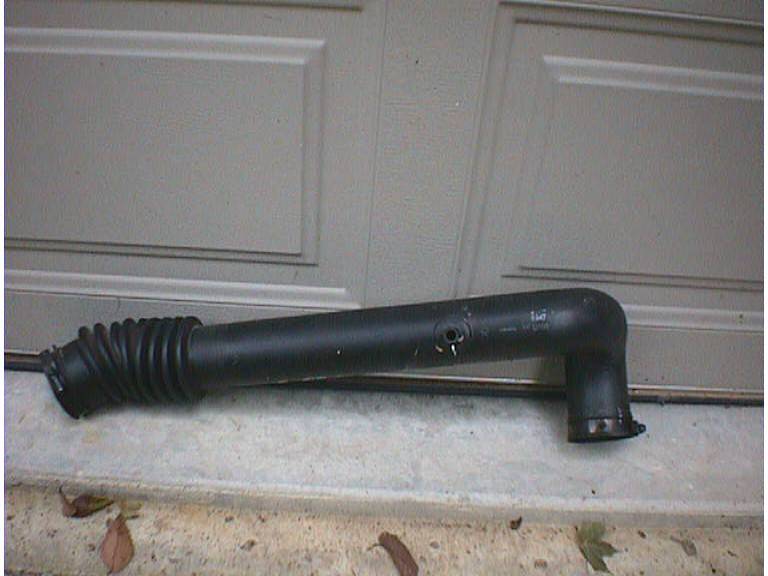
Place the factory air tube on your workbench with the bellows end to the left and the 90-degree bend end to the right. Find the PCV hose nipple and measure 2-1/4 (Two and one quarter) inches from the center of this nipple to the left (toward the bellows end). Please measure this again. One more time, please measure it again. (Measure 3 times, cut once rule!) Now cut the air tube at this measurement with a hacksaw. Try to make this cut as straight as possible, not like me.
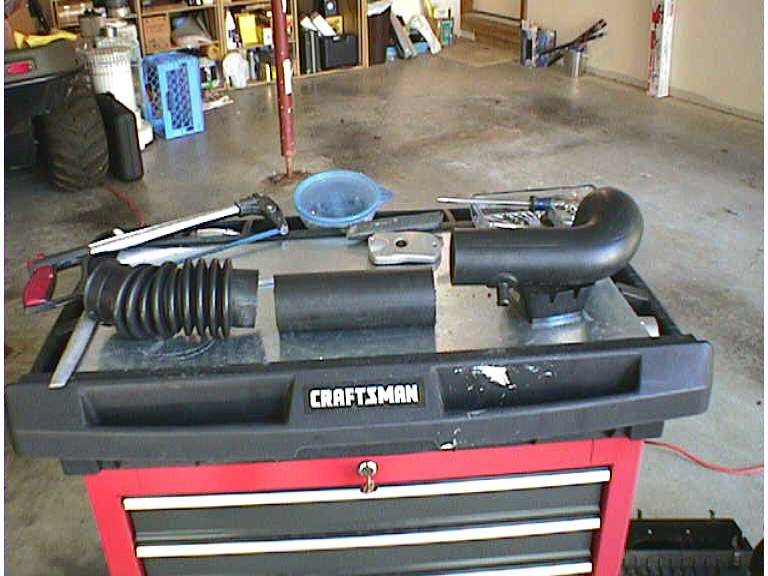
Your air tube should now be cut in half. Take the end on the left (the end with the bellows) and measure 7-1/2 (Seven and one half) inches from the cut you just made to the left toward the bellows. Mark this location. Measure this a few more times just to be sure. You are going to cut this 7-1/2 inch section of air tube off. When you are done you should have about 1-1/4 (one and one quarter) inches of smooth air tube left just to the right of the bellows. OK – Cut! – Straight!

Now you will have to reattach the left piece with the bellows to the right piece with the 90-degree bend. You will do this by cutting a 2 inch long piece of 2-1/8 inch inside diameter stainless steel exhaust pipe and using it as an inner sleeve between the two pieces of the air tube.
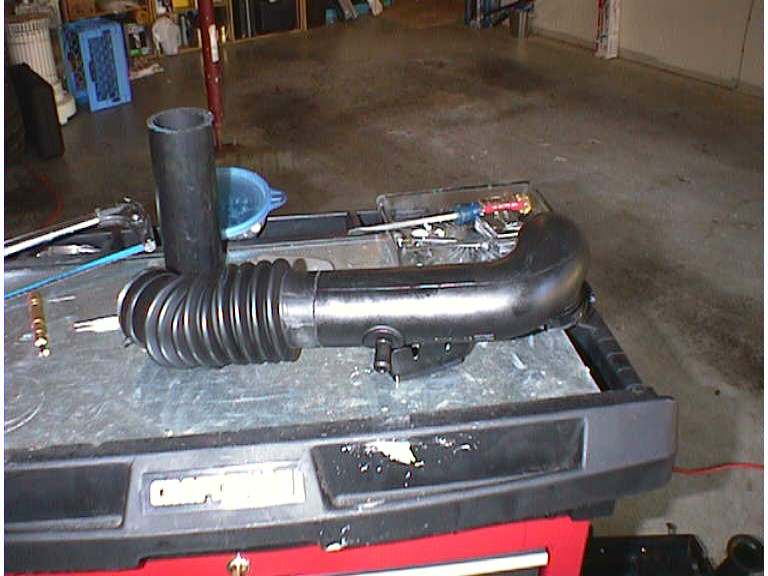
One inch of each end of this sleeve will be fitted to the ends of the air tube. The inside of the air tube is smooth, but trust me it is not round. You will have to grind and remove some material from the inside to a depth of 1 inch in order to fit the sleeve. I used a cone shaped stone grinder attached to my electric drill to do this. Be careful because the material comes off quickly and you want this to be a tight friction fit.
Instructions:
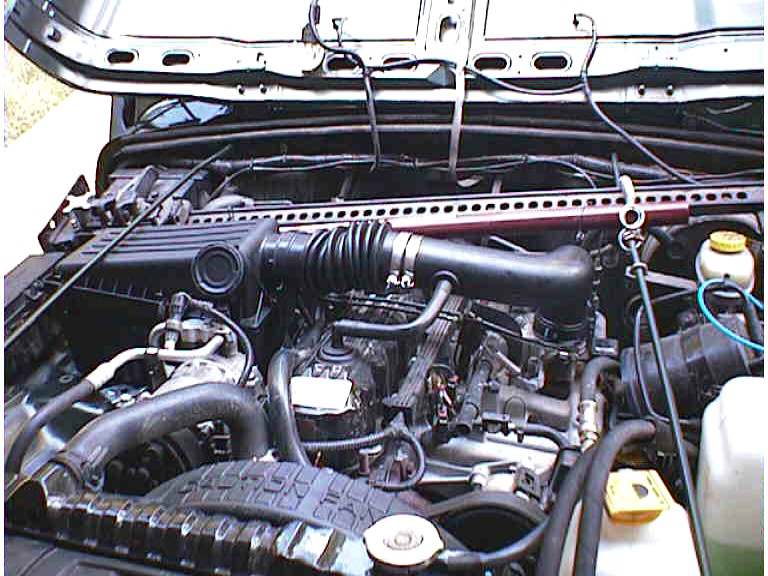
Once fitted to the inside of both air tube parts, place two 4-inch stainless steel hose clamps on the air tube and assemble into one piece. Leave the clamps loose at this time.
Place the air tube into the engine compartment and clamp the 90-degree end down on the throttle body. Rotate the bellows end until you get the best alignment position to the new air outlet horn and clamp the tube to the horn.
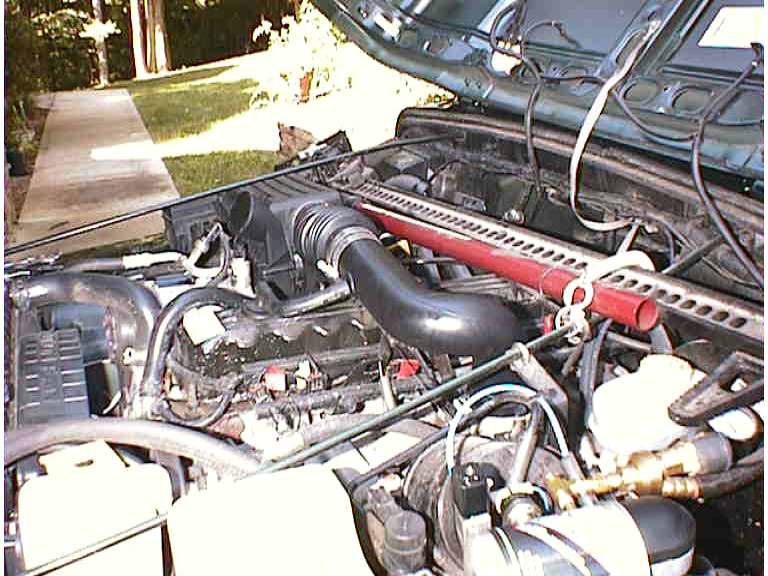
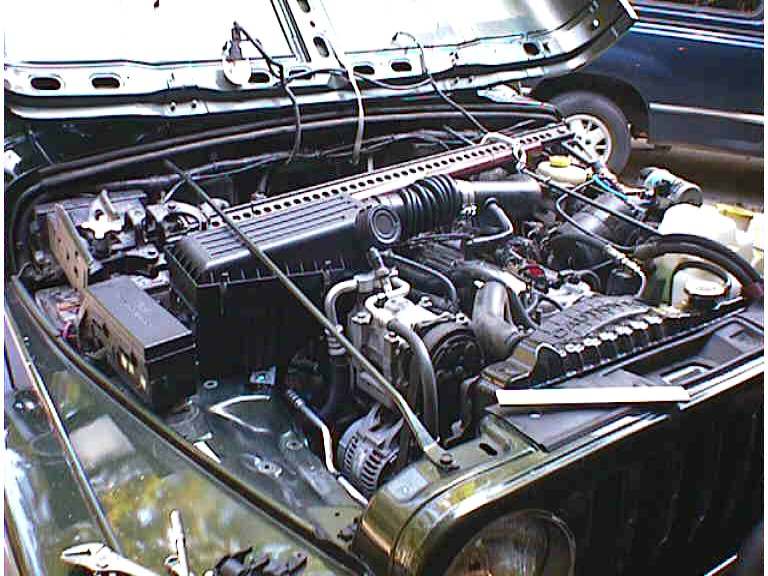

Mark the two halves of the air tube where they meet at the joint and then remove the air tube. Disassemble the joint and coat with RTV. Reassemble the joint and adjust to the alignment marks, then clamp the tube at this location with the 4-inch stainless steel hose clamps. Connect your snorkel to the lower air box inlet horn.
Fill all remaining holes in the bottom of the air box with RTV and let it dry. Put a filter in the air box and replace the top.
Install the shortened air tube and connect the PVS hose. Remove all tools from under the hood and start your engine. Check for clearance, rattles and vibration. All should be fine.
Break open a beer, sit back and admire your work. You�re done. Next project? Mounting the Kilby/York OBA system on all that newfound real estate under your TJ hood.
Fulfillment of Design Requirements
- Free up enough real estate under the hood to mount the Kilby/York OBA system
-
- All required space to fit the Kilby/York compressor is now available.
-
- Maintain integrity of the stock air filter box
- Air tight
- Water tight
- Continued use of flat K&N air filter
- No hardware (screws, nuts, bolts etc.) inside the air box
- Yes there are a few more holes in the air box, and more then a little RTV, but no hardware inside the air stream. I will monitor the condition of the RTV and all mechanical fitting to see how they hold up. K&N Flat Filter fits as it always has.
- No Rattles!!
-
- Been driving around for only a week with this setup. To date I have detected no rattles, vibration or rubbing of the relocated air box.
-
- No negative impacts to existing performance
-
- I cannot detect any performance degradation and do not really expect any. First two gas tanks of fuel have resulted in MPG equal to or greater then my previous average.
-
- Air filter must remain serviceable
-
- While the radiator support arm is close to the top of the relocated air box the top can be removed and the filter serviced. I suspect I will be bending this support rod up a little bit to clear the York compressor once it is mounted.
-
- Safari Snorkel installation must remain intact
-
- The 2-1/2 inch Safari Snorkel hose clamps directly to the new air inlet horn on the air box.
-
- Solution must be inexpensive and use commonly available parts
-
- If you have to buy every part needed to do this conversion the cost will be under $20. I had some of the parts and pieces lying around. My actual cost was $9.67.
-
- Provide filtered air to engine AND to air intake for OBA system
-
-
- I plan to put a tap in this block-off can to provide a source of filtered air for intake to my York compressor when I install it. I do not know if this will work but see no reason why it will not. I will keep you posed on it.
-
- Low heat transfer to intake air
I have a friend who owns a measurement / testing lab for use in the auto industry. I went back to his lab barrowed remote temperature measurement tool as I have before. I ran a full set of tests on four (4) different air intake systems for my 97 TJ.
I was able to measure the outside air temperature and the temperature of the air entering the Throttle Body at a location about two inches above the throttle body inside the air tube.
My objective was to determine the actual air temperature entering the throttle body, particularly in regard to the newly relocated stock air box connected to my Safari Snorkel.
Relative Humidity was a constant 75% during these tests.
Test Measurements:
Temperatures were taken as follows with each of the four air intake setups:
-
-
- At standing idle – 5 minute idle with hood closed
- During a 5 mile drive at 35 MPH (same trip each time)
- During a 7 mile Highway trip at 65 MPH (same trip each time)
- Outside Air Temperature
- Relative Humidity (From local weather forecast)
-
Intake System descriptions:
Intake 1 = Safari Snorkel to Stock Air Box with K&N flat filter in STOCK LOCATION
Intake 2 = Safari Snorkel to Stock Air Box with K&N flat filter in NEW LOCATION
Intake 3 = STOCK AIR BOX, in stock location with only K&N flat filter NO SNORKEL
Intake 4 = K&N Round Filter on Stock air Tube (RU-0960) NO SNORKEL
Test Results:

My testing certainly is not scientific but it is as accurate as I am able to produce with some topnotch equipment.
There does not appear to be any significant change in air temperature with the stock air box relocated to the new position sucking air through the snorkel. I view this as goodness.
What I find really amazing are the significantly higher air temperatures for the K& N air filter sitting stand-alone on the end of a stock air inlet tube.
Instinct tell me this set up has to be breathing more freely, but the measurement say it’s breathing much hotter air from inside the engine compartment. This may not be goodness, I don’t know.
I believe colder air is denser and packs more punch when mixed with the same amount of fuel then hotter air would. However, I can’t say I notice any significant performance improvements between the snorkel attached air box and the stand-alone K&N filter setup.
Ownership:
This document is being out into the public domain. Everyone and anyone are welcome to copy any part of this document or this idea. Improve on it, make it better and share it with the rest of us.
Comments can be sent to Frank (Daless2 on JU) email.id@worldnet.att.net
Project Parts List
Parts and Material List:
| Qty. | Description | Source | Cost | Notes |
| 1 | Stock Air Filter Box | Your TJ | N/A | |
| 1 | Stock Air Tube | Your TJ | N/A | Original air tube that goes from filter box to Throttle Body |
| 2 | 4 Inch stainless steel hose clamps | Auto Zone | $1.00 | |
| 1 | Ridgid Brand ShopVac Dusting Brush attachment | Home Depot
Part # 335-014 |
$3.97 | See picture below |
| 1 | 2 Inch Male/Female ABS pipe coupler | Ace Hardware
Part # 80320 |
$.98 | See picture below |
| 1 | 2-1/8 Inch Exhaust pipe sleeve | Auto Zone
Part # |
$1.77 | See picture below |
| 1 each | Stainless Steel Bolt, nut, washer, lock washer | Ace Hardware | $.32 | � inch diameter, � inch length.
SS to prevent rust |
| 3 | Stainless Steel Self-taping screws | Ace Hardware | $.21 | 1/8 inch diameter, � inch long |
| 10 | Aluminum Rivets | Ace Hardware | $.40 | 1/8 inch diameter, 3/8 inch long |
| 1 | Tube of Black sensor safe RTV | Auto Zone | $4.50 | Buy the good stuff |
| 1 | Aluminum or steel metal strap | Ace Hardware | $1.00 | 4 Inches long, 1 inch wide. 1/8 inch thick if aluminum.
See picture below |
| 1 | Aluminum plate | Ace Hardware / Home Depot | $2.00 | 6 Inches by 5 inches, 1/8 inch thick. |
| 1 | *Organic Can-U-Scent air freshener | Wal-Mart
UPC Code 7584782328 |
1.94 | **Please read note below
See picture below |
| $17.55 | TOTAL |
** Note on Organic Can-U-Scent
Trust me, you need to hunt this down in the auto section of your local Wal-Mart store. The container used by this air freshener is made of aluminum and it is a perfect friction fit to block off the original air outlet on the factory air box. There may be something else that works just as well but I haven�t been able to find it. This can will also be used as a “tap point” to pull clean filtered air as an input to the York compressor at a later date. Pick a fragrance flavor you will enjoy. I chose “Outdoor Breeze”! Trust me here too, when you open this can up and take the “stinky stuff” out your shop will smell for a week. (LOL)
** End of note on Organic Can-U-Scent
Tools I used:
- Miscellaneous hand tools, wrenches, screwdrivers, sockets, etc.
- Electric Drill
- Drill Bits
- 2-1/4 Inch hole cutter
- Rivet gun
- C-clamp
- round rat-tail file
- Utility knife
- Dremmel type tool / grinder
- Hacksaw
- Cone shaped stone grinding wheel
- Center Punch
The odd ball parts from the above parts list
Instructions:
Section One – Removing stock air intake system
- Remove the stock air tube by loosening hose clamps at the air box and over the throttle body. Pull the PCV hose off the air tube and then remove air tube. Place it on your bench; you will be performing surgery on it later.
- Unclip and remove the top of the air box. It too will be scheduled for surgery.
- Remove the flat filter. (If you are not already using the K&N flat filter now might be a good time to make the investment. The part number for my 97 TJ 4.0L is 33-2018) Set the filter aside where it won’t be damaged or get dirty. It will go back in when you’re done.
- Remove the bottom half of the air box. It is mounted to the wheel well using three 10 mm bolts going down through the fender well and attaches with three 10mm nuts inside the wheel well. Remove the nuts from inside the wheel well while holding the bolts with a wrench inside the air box. (These bolts are actually attached to air box by threaded spacers that you can’t see until you take the box out.)
- Remove the stock Air Inlet Horn from the lower half of the air box. This air inlet horn is “keyed” to the box. Rotate it slowly and you will get to a stop where it will just pop out. You will NOT be reusing the stock air inlet horn.
- Remove and save the three bolts and threaded spacers from the bottom of the air box. You will reuse two of these when we put the air box back in its new home. (DO NOT remove the rubber mounts that these bolts go through in the bottom of the box.)
Instructions:
Section Two – Surgery and Fabrication for the Bottom of Air Box
Since you have the bottom of the air box in your hands right now, we will start the real work here.
You are going to close off the rather large hole left from where the stock air horn was mounted. I did this by using the “Block-off” plate supplied with the Safari Snorkel. If you do not have this plate you will need to make one out of the 1/8-inch sheet aluminum plate. I have provided a template of this block-off plate. (After cutting and drilling this plate spray it with black to keep things looking neat if you care to.)

Template
Align the block-off plate on the air box to cover the original air inlet horn hole. Hold it in place with a c-clamp and then drill 1/8-inch holes through the air box plastic using the block-off holes as your guide. (You will be putting rivets through these holes in another few steps.) Remove the c-clamp and block-off plate and clean up the holes you just drilled in the lower air box.
Using the black sensor safe RTV put a 1/8-inch bead on the outside of the air box around the large air inlet horn hole. Also put a bead around each hole you just drilled. Let this set for 5 minutes.
Place the block-off plate over the original air box inlet hole and line it up with the drilled holes. Hold the plate in place with the c-clamp. Get your rivets and rivet gun and rivet the block-off plate in place with 5 rivets. Remove clamp.
Put a bead of RTV on the outer edge of the block-off plate where it meets the air box. Also put a bead of RTV inside the air box where the block-off plate and original air inlet horn hole meet. Smooth RTV with your finger.
Dab a small drop of RTV on all rivets inside the air box.
Set lower half of air box aside to dry.
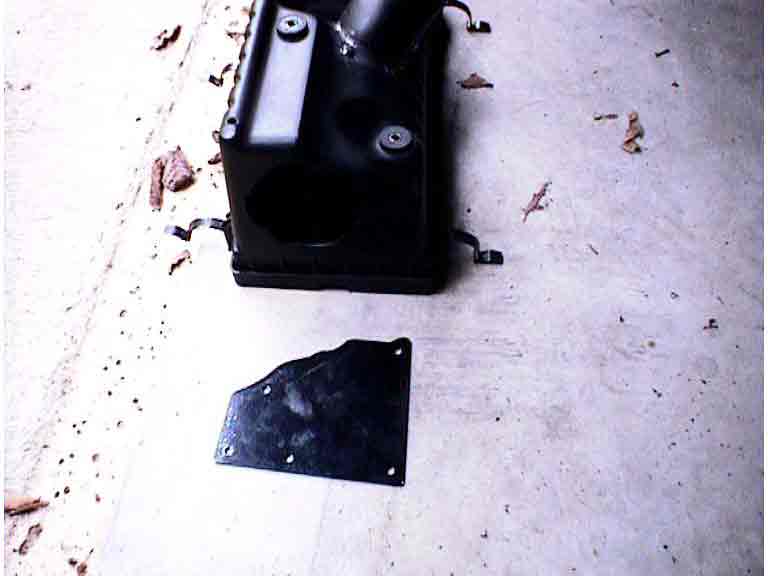
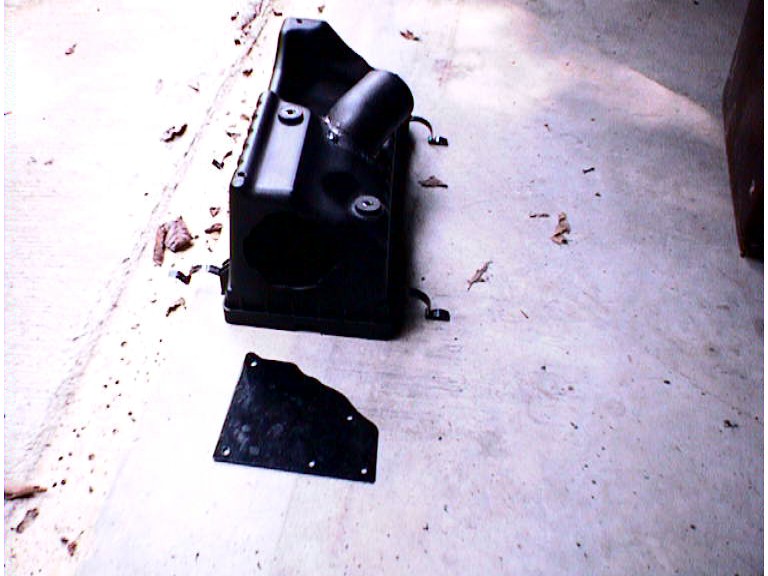
Instructions:
Section Three – Fabricating the new Air Horn Inlet Tube
You will be using the Ridgit Brand Shop Vac Dusting Brush Attachment to fabricate a new air inlet horn in the lower air box. The Safari Snorkel will clamp directly up to this part.
I would imagine you could also attach an air inlet hose here as well to use the Hellbender snorkel under the front cowl, but I can�t guarantee this. You could also just leave this air inlet horn open if you do not use a snorkel.
Note: I do not know what type of plastic this part is made of, as there are no markings on it that would provide a clue. I have however tested its ability to withstand the under-hood temperatures. I did this by wiring it up on top of the intake manifold and drove around for a week with it there. I could not see any change to the part as a result of the heat it was exposed to.
Take your Ridgit Brand Shop Vac Dusting Brush Attachment and pull the bristles out of it. They are mounted on a metal ring that slips into a U-shaped channel. You should be able to pull them all out as a unit with a pliers.
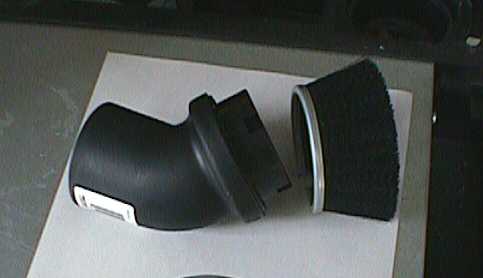
Do you see the U-shaped channel where the bristles used to be mounted? You need to trim both the inner and outer sides of this U-shaped channel back to about 1/8-inch tall. This is to help prevent any unnecessary airflow restriction. I used both a hacksaw and utility knife to do this. (This doesn�t have to be perfect. Just make them smaller.)
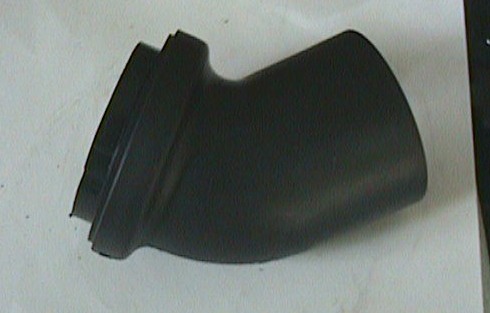
Instructions:
Section Four – Mounting the New Air Inlet Horn in the Bottom of Air Box
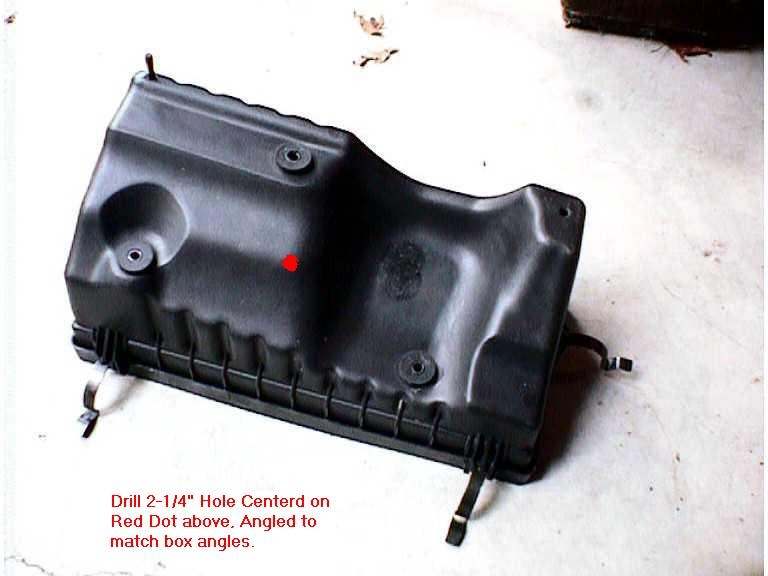
Turn the air box bottom over so you are looking at the bottom of the box. Find the spot where you will drill a 2-1/4 inch hole. (See red dot in picture.) The drill center is right at the pinnacle of multiple curves. Sorry but I found it impossible to make a template for this but I think you will find it correctly based on the pictures.
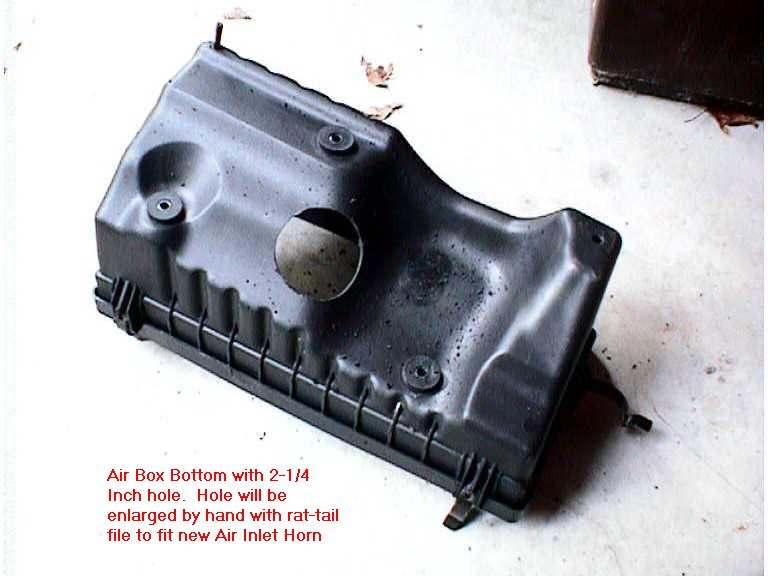
Drill the 2-1/4 inch hole in the bottom of the air box and then take your round rat-tail file and enlarge this hole until you can fit the small end of the newly fabricated inlet tube (Shop Vac tube) through it from the inside. Make this a tight friction fit. If done correctly the new inlet tube will fit all the way up to the U-shaped channel.
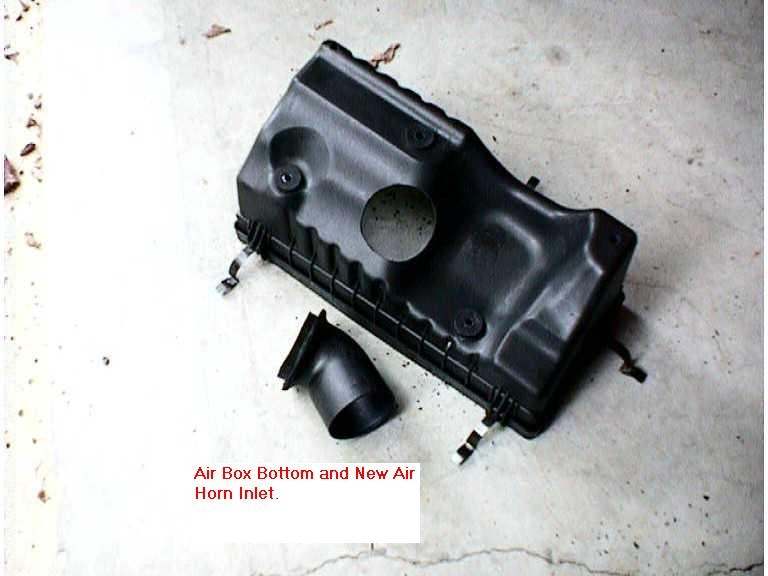

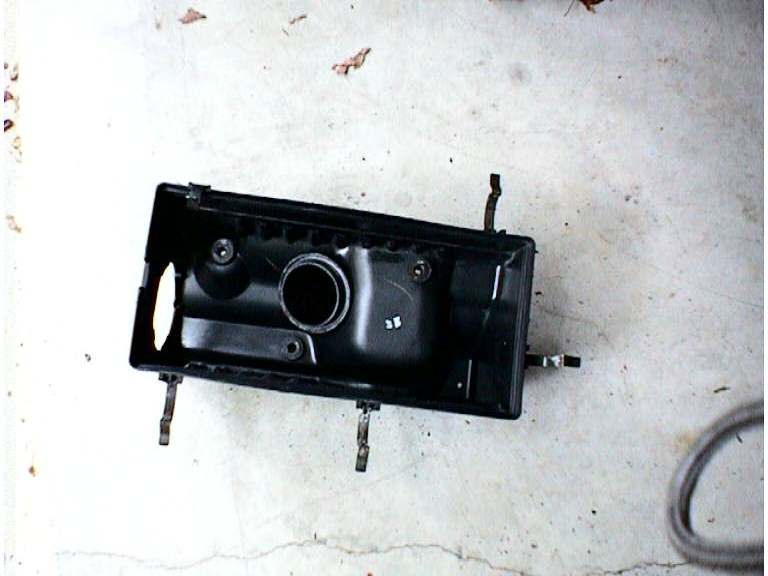
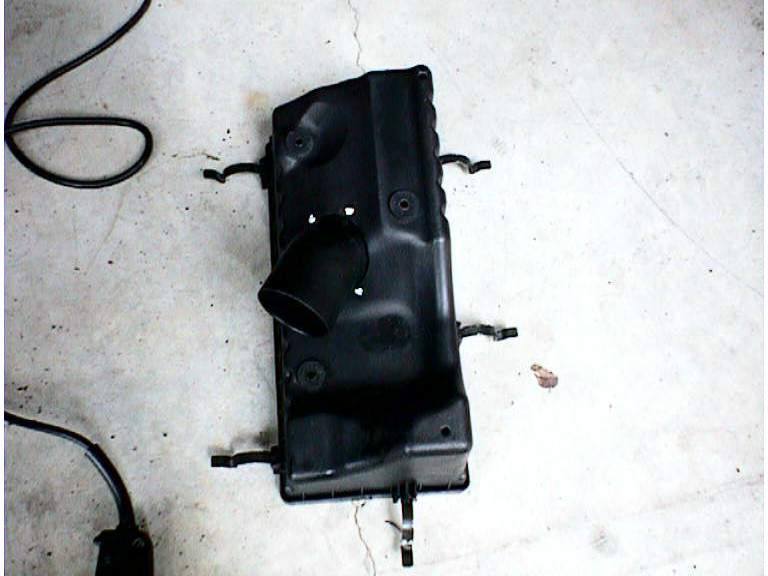
After fitting the hole to the newly fabricated air inlet tube, you will need to drill 3 holes through the new air horn u-shaped channel and the air box. Position the air horn at approximately a 45-degree angle to the long side edge of the air box. This angle is not critical but should be close in order to run the snorkel inlet hose to it. If your setup is different just point the new air inlet horn in the general direction of where the inlet hose will be. Drill three small holes through the air box and the new air horn u-shaped channel. Try to space these holes as evenly as possible around the air horn but consider you will need room to screw in the 3 self-taping stainless steel screws in these holes.
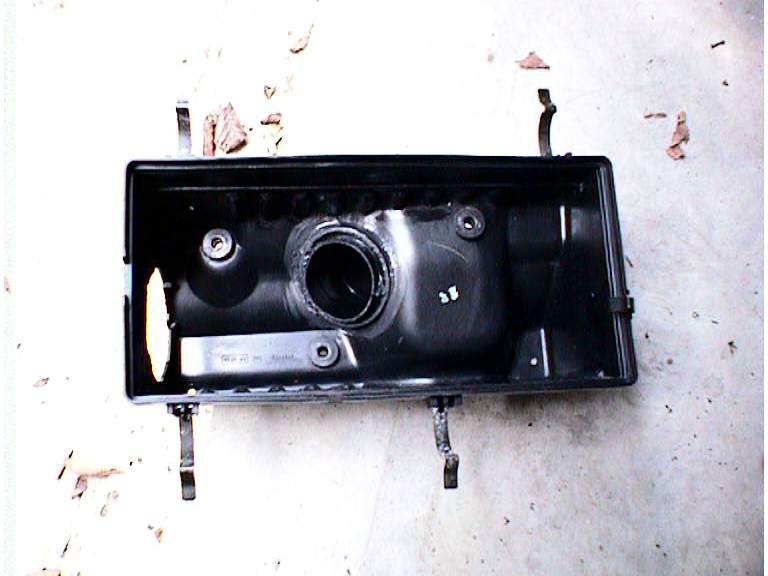
Put a 1/8-inch bead of RTV around the new air horn on top of the U-shaped hub (outside flange) and slip the air horn through the inside of the air box. Screw the air horn down with the 3 ss self-taping screws. (The screws go on the outside of the air box, through the air box and into the air horn u-shaped channel.) These screws provide a good mechanical connection between the air box and the new air horn. However this connection must be more air/water tight.

Apply a liberal coat of RTV to both the inside and outside of the air box where the new air horn comes in contact with the air box, Get carried away here! But be neat too! Be sure to cover the mounting screws as well.
Set the air box bottom aside to dry. All modifications to this part are now complete.
Instructions:
Section Five – Modifying the upper air box
You will need to make two modifications to the upper air box, closing off the original air outlet horn, and fabricating and mounting a new air outlet horn.
Now we will do the work required to seal the original air outlet horn hole. Get your Can-O-Scent air freshener and a plastic bag. Open the Can-O-Scent and remove the three sponges, which are swimming in really strong stinky stuff. Put them in the plastic bag and seal it to try to control the smell. Wash the aluminum Can-O-Scent Can and remove the label from the side. If you care to, now is a good time to paint the bottom of the can. (I did mine in black Hammerite.)
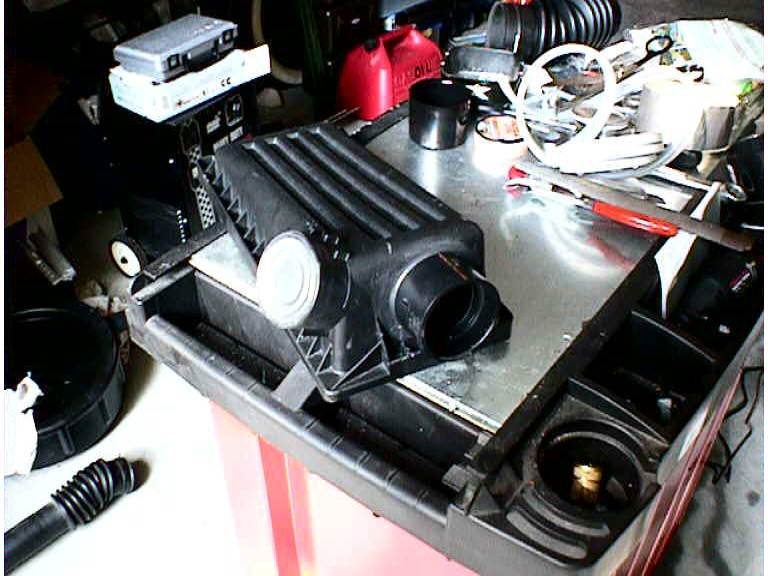
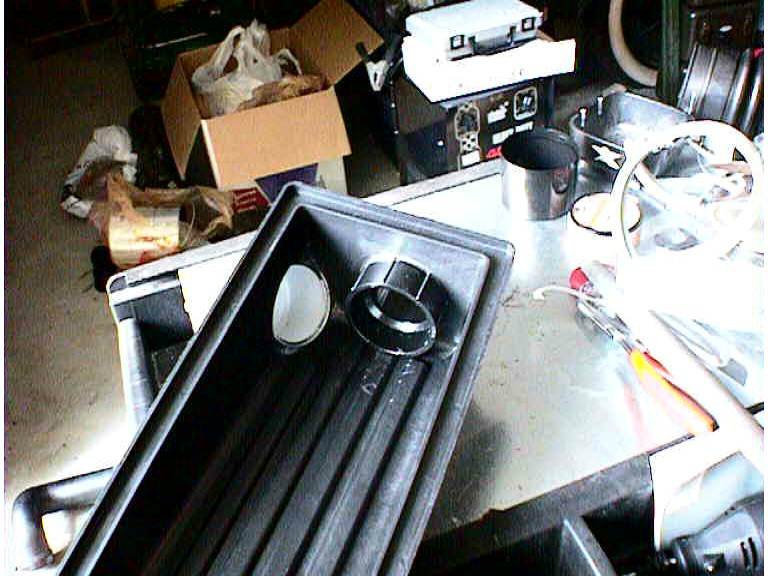
Coat the entire side of the aluminum can with the black RTV and then push the can into the original air outlet horn hole from inside the air box. Get it all the way in there. A lip on the bottom of the aluminum can will stop your progress when it is all the way in.
Drill two 1/8-inch holes through the sides of the old air horn and the aluminum can. Put two rivets through these holes to provide the necessary mechanical connection to hold this block-off plate in place.
Using more RTV seal the inner and outer edges of the air box and the aluminum can, which is now the block-off plate. Also dab the two rivets with RTV.
Note: I plan to put an air tap (Fitting) in this block-off can to provide a source of filtered air for intake to my York compressor when I install it.
Instructions:
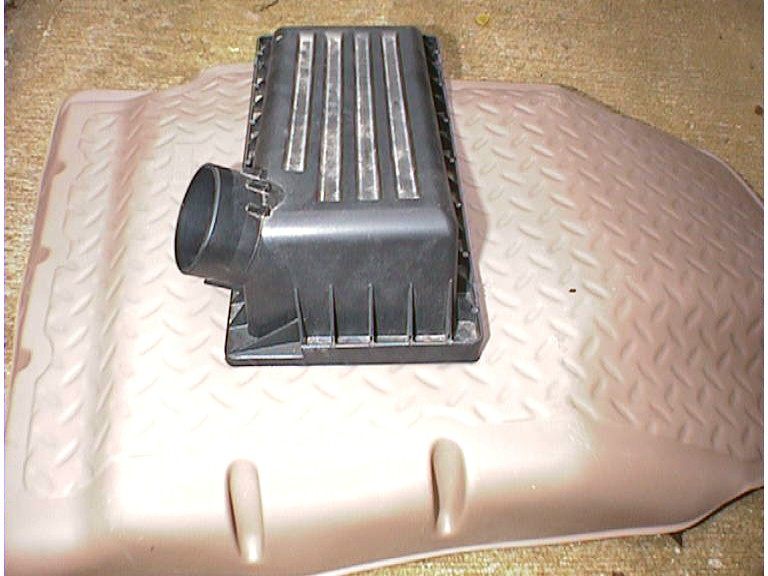
Look at the ends of the upper air box cover and you see one end sits about four inches higher then the other end. Do you see the 5 plastic ribs on this side? You will need to remove the 3 middle ribs. Cut them off and file them down so that the outside of the upper air box is flat (flush) at this location. I used a dremmel tool and a utility knife to do this. Only remove the three middle ribs. Leave the extreme left and extreme right ribs untouched.
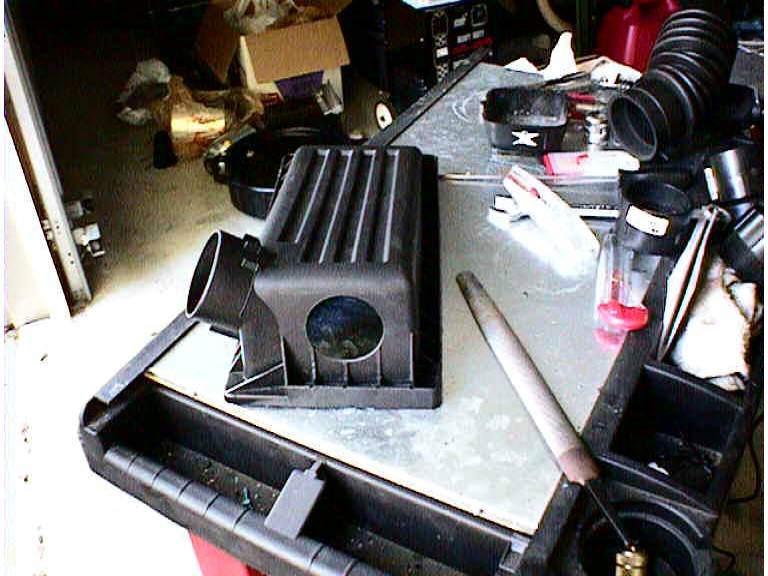
Drill a 2-1/4 inch hole in the upper air box where you have just removed these 3 ribs. Center this hole as best you can, as the ABS Male/Female pipe coupler will be mounted through this hole. Using your round rat-tail file, enlarge this hole for a friction fit of the threaded male end of the pipe coupler. Then clean up any filing debris from the hole.
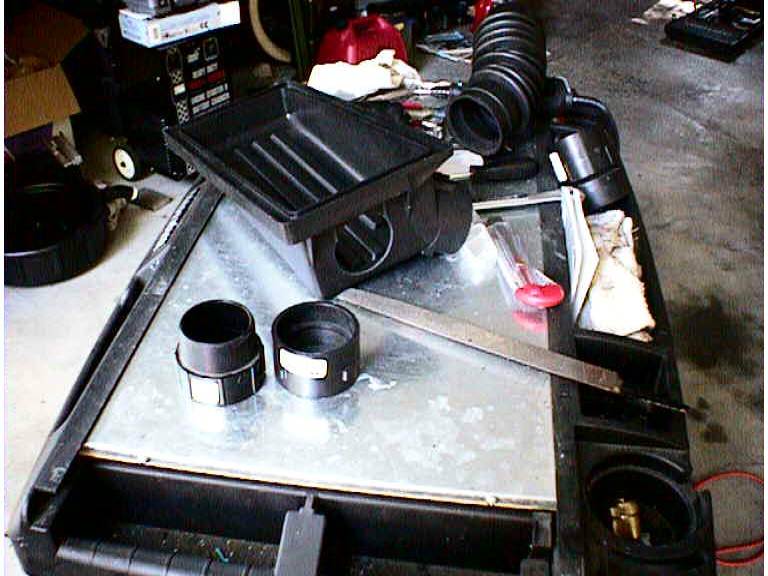
Place a 1/8 inch bead of RTV along the inner flange of the male end of the pipe coupler (where the threads end and the body begins) and then slip the male coupler through the hole from the inside of the air box.
Place a second 1/8-inch bead of RTV on the threads of the male coupler where they come through the air box on the outside.
Thread (you thought I was going to say “Screw” now didn�t you?) the female end of the coupler onto the male end from outside the air box and tighten it down. Make this tight!
Run additional beads of RTV along the inside and outside of the airbox where the new air outlet horn meets the air box and smooth the RTV with your finger. Set box aside for a few minutes to dry.
Modifications to the upper and lower air box are now complete
Instructions:
Section Six – Mounting the Air Box under the Hood
The modified air box will now be rotated 90 degrees clockwise and mounted to the inner wheel well behind the factor air compressor. You will need to fabricate one support bracket and drill two holes.
Please note that it is beyond my ability to make a template for where these two holes need to be drilled. The surface area on the inner wheel well is concaved, convexed and convoluted all at the same time! However, if you follow these directions I am sure you will be successful.
Refer to pictures Template, MountHoles, MountingBolts, and MountingInside and TrialFit.jpg for this section of the instructions.

Fabricate the mounting bracket from your 5-inch x 1-inch x 1/8-inch thick aluminum stock. See picture template.jpg for a template and measurements for this bracket. Drill hole in the bracket where indicated on the template drawing. You will need to bend this bracket slightly in the center approximately 10 degrees. Get it close. You will adjust this bend later.
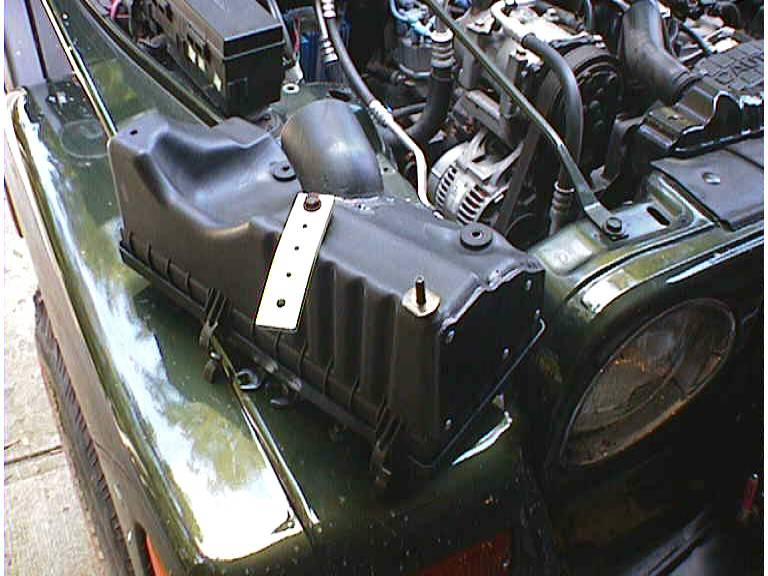
Mount this bracket to the bottom of the air box through one of the original rubber mounts. Use the original mounting screw and nut, but not the threaded spacer. Hand tighten the nut.
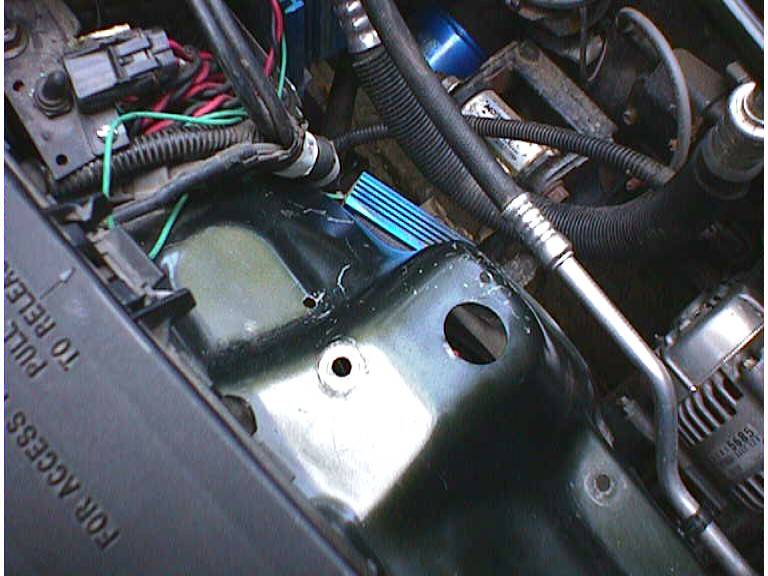
Place the air box bottom in position behind the factory air compressor. (This is its new home.) Swing the bracket you fabricated out until it extends to the top of the shock absorber tower. (Near the large shock absorber access hole.) Position the air box so that it clears everything and then bend the bracket so that it fits flush on top of the shock tower.
Mark the spot on top of the shock tower where the bracket hole is centered. You will be drilling a hole here. Remove the air box and use a center punch to better mark where the hole should be drilled. Drill the hole. Be sure to paint the edge of this hole to help prevent rust.
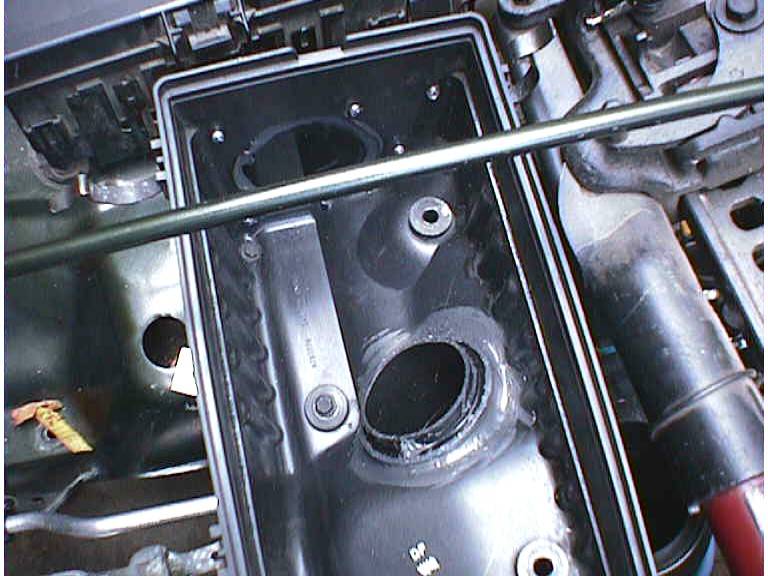
Put your air box back under the hood and mount the bracket using the bolt and nut and hand tighten.

Clip the upper air box to the lower air box and check for clearance. If you need to adjust you can bend the bracket or elongate the bracket-to-wheel well mounting hole. Once aligned and clearance is verified, remove the upper air box. Look inside and you will see a factory “Drain Hole” in the corner of the air box where it is contacting the inner wheel well. Mark the wheel well through this hole. You will be drilling the second hole here.
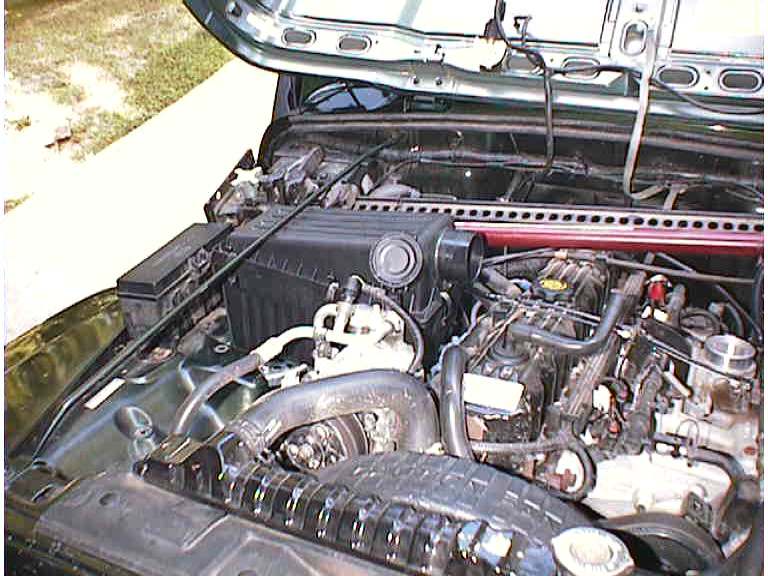
Remove the air box and use a punch to better mark where you will be drilling the hole. Drill a hole at this location.
Take one of the original air box mounting bolts and place it through the drain hole in the air box from the inside. Thread one of the original spacers to this bolt from the underside of the air box.
Place the air box into position in your Jeep and slide the bolts into the two holes you drilled. Tighten all three nuts down (two in bracket and one in air box/fender). Clip the top ofthe air box on and check that nothing is hitting or rubbing. Adjust as necessary. My installation clears everything, including my under hood Hi-Lift Jack.

